When you’re looking up at the night sky, you might notice some stars stand out as brighter and different in color from others. Most stars in space are ‘main sequence’ types, like our Sun. But, the standouts we see are the ‘giants’.
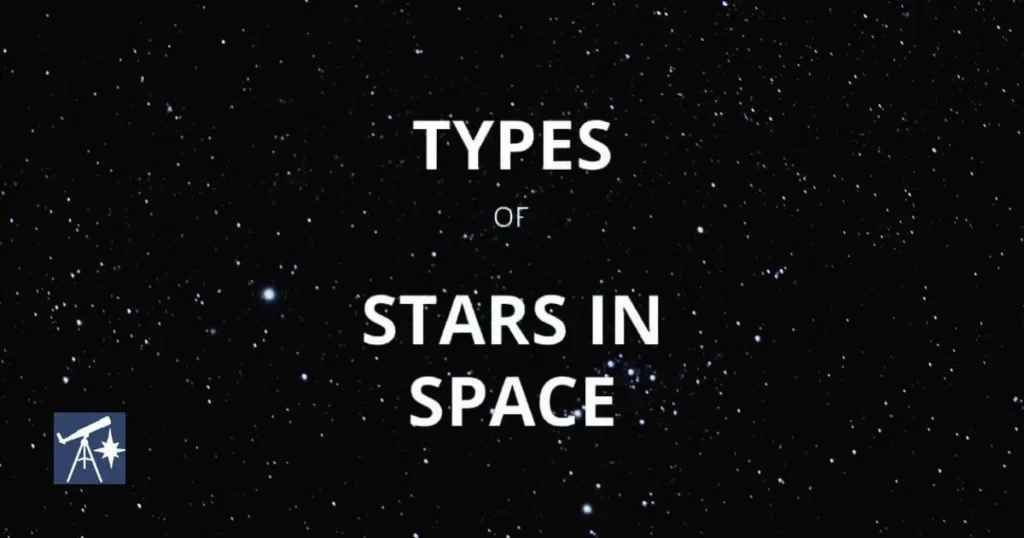
Stars are celestial bodies that emit light and radiation.
How many different types of stars are there?
There are over a dozen kinds of stars in our sky but most stars in space fall into three main groups:
— Main Sequence: dwarf stars, yellow dwarf, red dwarf (young stars)
— Giants: Blue, Red, Supergiants (old large stars)
— Faint small: White, Brown dwarfs, Neutrons, Pulsars (fading or dying)
Dwarf stars account for 90% of stars known in our Universe and vary from blue to red, indicating their wide range of temperatures.
The main star types correspond to a stage in the ‘life’ of the star. But the details are more intricate, as depicted in the tree of the stellar life cycle shown below.
For the sake of maintaining the interest of budding astronomers, I’ll center the following on the sort of star relevant for your night sky viewing…and then include some others for interest.
types of stars in space
You can use binoculars, or your eyes unaided to star hop between the different types. A star chart will help you find the different stars in the sky for the particular night you’re looking.
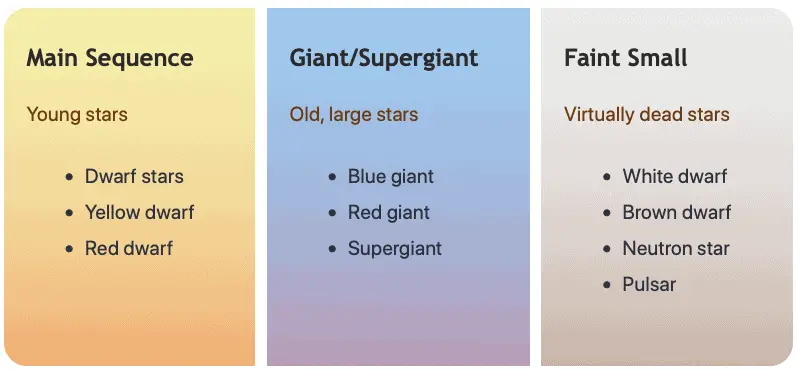
Main sequence dwarf Stars
The main sequence stars fuse hydrogen to form helium in their cores. They include yellow and red dwarf stars. On the star temperature chart, yellow dwarfs are hotter than red dwarf stars.
A yellow dwarf is the type of star the Sun is. You’ll see our Sun fitting in among the main sequence stars in the star spectral class chart shown. If you look at the OBAFGKM chart axis, you’ll see our Sun is a G type within the spectral classification.
Only a ‘young’ star, with an estimated age of 4.6m years and a lifespan of about 10 billion (1010) years, our Sun is expected to last another 7 billion years.
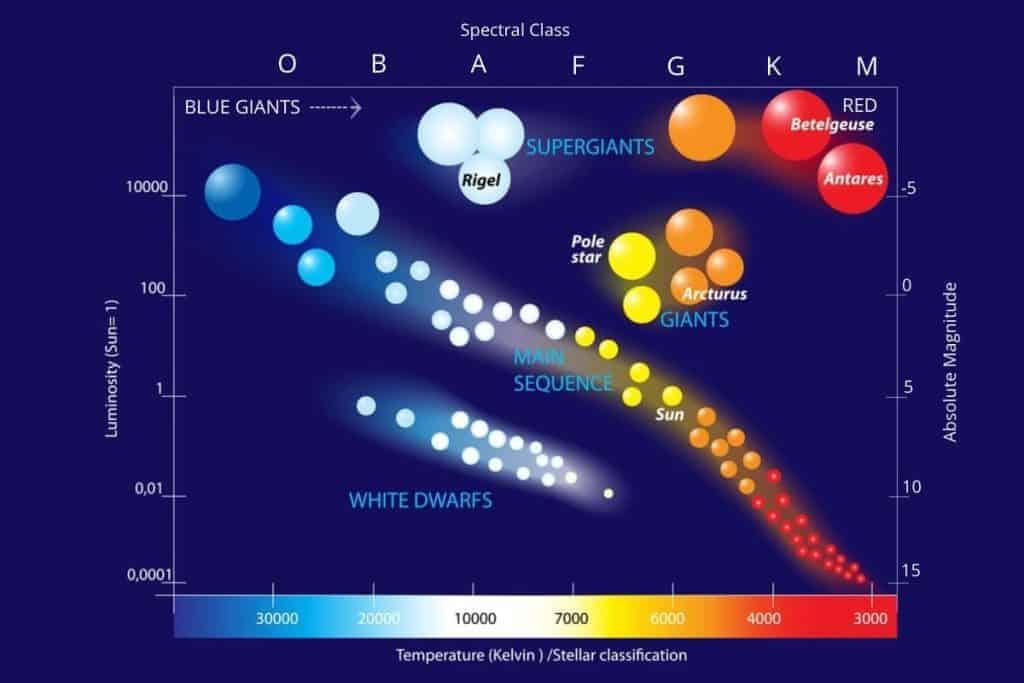
This is a Hertzsprung-Russell diagram, which is a type of star classification chart displaying spectral type and surface temperature against luminosity and absolute magnitude. Luminosity is measured per that of our Sun (value = 1). Source credit: CSIRO
Red dwarfs are the most common stars in our Milky Way but are too faint to see with the naked eye.
Examples of dwarf stars to locate:
- Sirius A — blue-white (in constellation Canis major)
- Beta Centauri — blue (one of the pointer stars, seen in the southern hemisphere)
- Alpha Centauri A and B — yellow (part of the pointer stars, southern hemisphere)
- Barnard’s Star — red (in constellation Ophiuchus)
Sirius A is a main sequence dwarf in the blue-white spectral range. It’s the brightest star in the night sky, not necessarily the brightest object (see Venus). It is a spectral type A in the white spectrum range.
In the blue spectral range is Beta Centauri, which along with its ‘neighboring’ triple star Alpha Centauri (Alpha Centauri A, B, & C) is prominent in the southern hemisphere skies. These stars are what is known as the ‘pointer stars’ directing observers to the Southern Cross.
Both Sirius A and Beta Centauri can be seen by the naked eye and are easy to spot.
Alpha Centauri A and B look to us as a single bright star, unless using a telescope with which you should see them separated — This is a good one for kids to practice using their telescope.
Yellow dwarfs include Alpha Centauri A and B, Tau Ceti, and 51 Pegasi. Our Sun is also a yellow dwarf (but viewing the Sun through a telescope unshielded like with naked eyes is off-limits).
Barnard’s star: Named after the astronomer, E. E. Barnard, Barnard’s star is a low-mass red dwarf within our Milky Way.
Proxima Centauri (AKA Alpha Centauri C) is another example of a red dwarf. The red dwarfs are low-mass stars, that are the longest-lived and the most common type of star in the Milky Way. But, they are not easily seen.
The place to point your telescope for observing Barnard’s Star is near the celestial equator. In the northern hemisphere, it is best seen in summer (June) high in the sky in the constellation Ophiuchus. Its neighbors are Sagittarius, Scorpius, and Libra.
Barnard’s Star is smaller and older than our Sun of 4.5 billion years. It has been described as a flare star, which is one that has bursts of brightness at random but at relatively rare times, as in the one seen in 1998.
Giant Stars / Supergiants
The best-known examples of giants that are visible to the naked eye include:
- Canopus — yellowish-white giant (in the constellation Carina, the Keel — a southern hemisphere constellation)
- Polaris Aa — yellow giant (northern hemisphere pole star in Ursa Minor)
- Arcturus — red giant (in the constellation Boötes, northern hemisphere)
- Aldebaran (Alpha Tauri) — red giant (in the constellation Taurus)
- Mira (Omicron Ceti) — red giant (in Cetus in the northern sky)
You might see Canopus in the northern hemisphere if you’re in the lower latitudes (roughly below +37).
Red giants
A red giant star is a dying star. These types have run out of hydrogen.
Blue giants
Blue giants are large and extremely hot stars. They burn helium and are what follows from the main sequence stage.
Yellow giants
Yellow giants are the intermediates of the many types of stars in the sky.
Supergiant stars
Supergiants are the biggest and most luminous of the stars seen from Earth. Their temperature can range from about 3,450 K to over 20,000 K (red to blue spectrum).
Although rare and short-lived they are super bright.
Examples of supergiants you can see with your naked eye:
- Rigel — bluish-white (in Orion)
- Deneb — bluish white (in Cygnus and part of the asterism Summer Triangle)
- Antares — red (in Scorpius, not to be confused with Mars)
- Betelgeuse — red (in the constellation Orion)
Rigel and Deneb are the brightest stars in their respective constellations.
Betelgeuse is 1000x the size of and 14,000x brighter than our Sun.
Antares is less luminous than Betelgeuse but it stands out like Mars with its reddish hue.
Blue Hypergiant stars
Described as the Most Powerful Star In The Universe: The Pistol Star is a type of blue hypergiant star located in the Milky Way Galaxy, specifically in the Quintuplet Cluster near the Galactic Center.
It is one of the most massive and luminous stars known to astronomers, with an estimated mass of 100-150 times that of the Sun and a luminosity over a million times greater.
Unfortunately, you won’t see the Pistol Star from your backyard telescope, even under the best conditions. This is because the star is located in the Galactic Center, which is heavily obscured by dust and gas clouds that block most of the visible light and make it invisible to the naked eye.
Faint small types of star
White Dwarfs
A white dwarf is a small star in space that has exhausted its nuclear fuel. These are dense stars comprised of carbon. Their surface temperatures are hot.
Sirius B is a white dwarf and can be found alongside its brighter companion Sirius A, a main sequence star, in the constellation, Canis Major. Sirius B is quite a hot little star in comparison to our Sun.
Neutron Stars
You’re not able to see these with the typical backyard instruments. These are very dense small celestial objects with a radius of about 12-18 miles (20-30 km), of mostly packed neutrons. They are thought to be a collapsed center, a remnant of a giant star. It’s a stage at the end of the star’s existence.
SR J0108-1431 in the constellation Cetus (the Whale), in the northern sky, is the closest neutron star to us and is a pulsar…
Pulsar
Pulsar stars are neutrons that are highly magnetized and rotate, emitting a beam of electromagnetic radiation. The SR J0108-1431 in the constellation Cetus (the Whale) is an example, mentioned above and shown in the image here…
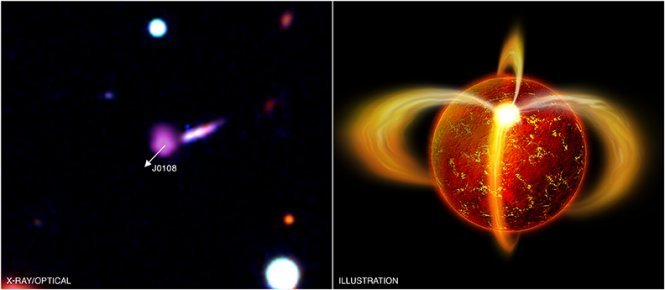
(Image: X-ray: NASA/CXC/Penn State/G.Pavlov et al. Optical: ESO/VLT/UCL/R.Mignani et al. Illustration: CXC/M. Weiss)
Brown dwarfs
A brown dwarf is a failed star. You’re not likely to see these, as UCLA astronomy professor, Ian Mclean explains: “Brown dwarfs are so elusive, so hard to find”.
And about them: “Brown dwarfs are the missing link between gas giant planets like Jupiter and small stars like red dwarfs”.
Some authorities group them as main sequence stars.

The rarest star type
The rarest type of star is known as a Wolf-Rayet star or WR star. These massive stars are incredibly hot and bright, with surface temperatures reaching up to 200,000 Kelvin. They are also extremely luminous, with some Wolf-Rayet stars shining up to millions of times brighter than the Sun.
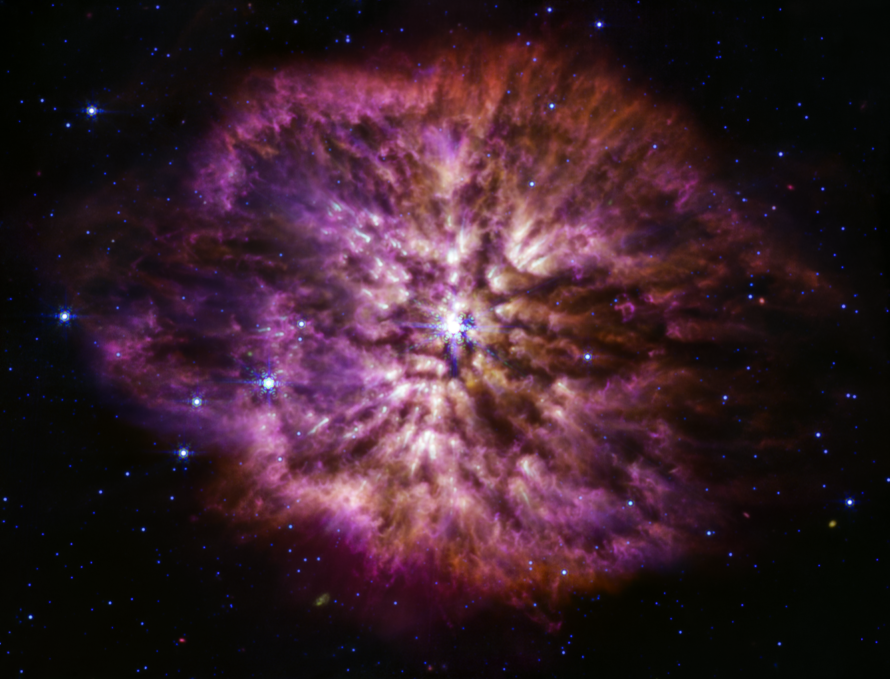
Credits: NASA, ESA, CSA, STScI, Webb ERO Production Team
Wolf-Rayet stars are rare because they are in a short-lived phase of stellar evolution, lasting only a few hundred thousand years before they explode as supernovae. They are also difficult to detect because they are typically located in distant galaxies and are often obscured by dust and gas.
Observing a Wolf-Rayet star requires a powerful telescope and a good location with minimal light pollution.
The Wolf-Rayet stars are very hot and bright, and they emit most of their energy in the ultraviolet part of the spectrum. So you’d need a telescope capable of capturing this part of the spectrum.
Other star types
Let’s look at others — the type of stars you might see mentioned and of interest.
Variable Stars
These stars are so named because they change in brightness (as seen from Earth). They are useful to observe, as I explain in my article on why you should target variable stars.
The reason they vary can be due to the star itself shrinking and expanding or because another celestial object eclipses it. There are around 42,000 variable stars.
Examples are R And in the constellation Andromeda, T Aqr in the constellation Aquarius, and the variable star, Mira (Omicron Ceti), in Cetus.
T Tauri Star
This is a class of variable stars that are relatively young (< 10 million years). The temperature at the core of these is too low for hydrogen fusion. How are they powered? Gravitational energy driven by the contraction of the star is their source of power.
The nearest T Tauri stars to us are in the Taurus molecular cloud in the constellations Taurus and Auriga, and the ρ-Ophiuchus (pronounced rho oh-fee-ook-ee) molecular cloud of the constellation Ophiuchus, both about 400 light years away. More than 200 T Tauri stars are estimated in the Rho-Ophiuchus molecular cloud.
Runaway Stars
A runaway star is one moving at a speed and direction through space abnormal to the surrounding interstellar matter, which includes gas, dust, and cosmic radiation. An example of a runaway star is GD 50, which is a white dwarf star, smaller than our Earth with slightly more mass than our sun.
Hypervelocity Stars
These are stars that move at high velocities. In 2005, one was recorded that moved at a velocity of 2 million mph. It was coined an ‘Outcast’ star, ejected by the Milky Way. They are associated with black holes.
Intergalactic Stars
These are sometimes termed rogue stars because they are not gravitationally bound to any galaxy.
Halo Stars
This is a group of globular clusters and field stars. These encircle the outer edge of spiral galaxies including the Milky Way in an area called the ‘halo zone’. They are thought to be the oldest stars in the galaxy.
Protostar
What is a protostar? As the name suggests (proto- first or earliest), it is an early stage — a forming star. It’s basically a gas mass that’s contracting.
FAQs
What is the most common star in the Milky Way?
The most common type of star in the Milky Way galaxy is the red dwarf, which is a small and relatively cool star that is much less luminous than the Sun.
Info sources
Colors of the stars, see: www.vendian.org/mncharity/dir3/starcolor/ | CSIRO: Spectral Classes | NASA: Hubblesite | Space.com
